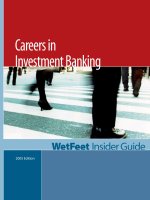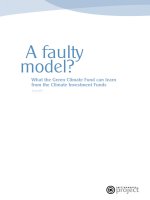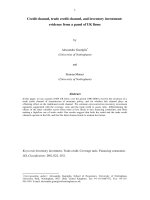Investment intelligence from insider trading
Bạn đang xem bản rút gọn của tài liệu. Xem và tải ngay bản đầy đủ của tài liệu tại đây (1.3 MB, 443 trang )
Investment Intelligence from Insider Trading
Investment Intelligence from Insider Trading
H. Nejat Seyhun
The MIT Press
Cambridge, Massachusetts
London, England
1998 Massachusetts Institute of Technology
All rights reserved. No part of this book may be reproduced in any form by any electronic
or mechanical means (including photocopying, recording, or information storage and
retrieval) without permission in writing from the publisher.
This book was set in Stone Sans and Stone Serif by Achorn Graphic Services, Inc.
Printed and bound in the United States of America.
Seyhun, Hasan Nejat, 1954–
Investment intelligence from insider trading / H. Nejat Seyhun.
p.
cm.
Includes bibliographical references and index.
ISBN 0-262-19411-2 (hc : alk. paper)
1. Insider trading in securities—United States.
HG4910.S416
I. Title.
1998
364.16′8—dc21
98-24347
CIP
To the loving memory of my parents
Contents
Preface
xiii
Acknowledgments
Introduction
1
xvii
xix
Insider-trading patterns
Some preliminaries
1
1
Conflicting transactions
3
Frequency of insider trading
5
Insider-trading cycles
6
Probability of trading against insiders
Normal insider-trading patterns
Seasonal patterns in insider trading
Do insiders manipulate stock prices?
Insider-trading regulations
8
14
17
18
23
Should insider trading be regulated?
28
Conclusions and investment implications
2
32
Does insider trading predict future stock returns?
Background
35
Stock price movements following insiders’ transactions
Relative performance
41
35
37
Contents
viii
Year-to-year profitability of insider trading
43
Duration of the stock price reaction to insider trading
Prior stock price movements
49
Profitability of active and passive transactions
Strengthening insider-trading signals
58
Do insiders manipulate stock prices?
61
Conclusions and investment implications
3
A stock-picking strategy
54
63
67
Additional indicators of profitability
67
Identity of insiders
68
Volume and profitability of insider trading
74
Interaction between volume and identity of insiders
Volume and officers and directors
Volume and top executives
Sales versus purchases
46
80
83
84
86
Firm size and profitability of insider trading
89
Interaction among identity of insiders, firm size, and volume of
trade
92
Consensus among insiders
98
Insiders’ option exercises and other transactions
Conclusions and investment implications
104
4
Predicting future market returns
Market timing
107
107
Aggregate insider trading
109
Aggregate insider trading and future real activity
50%–50% rule
100
111
114
Implications for the mutual fund investor
124
Other cutoff rules
125
Other market-timing strategies based on aggregate insider
trading
128
Contents
ix
Predicting industry returns
131
Conclusions and investment implications
5
134
Crash of October 1987 and insider trading
137
Why did the stock market crash in October 1987?
Anatomy of the crash
137
140
Insider trading around the crash of October 1987
Conclusions and investment implications
6
Dividend yields and insider trading
143
149
151
Dividend yields and future stock returns
151
Predictive ability of the market dividend yield
153
Forecasting characteristics of dividend yields
155
Market dividend yields and aggregate insider trading
Intensive insider trading and dividend yields
Changes in dividend yields
Firm-specific dividend yields
166
170
Conclusions and investment implications
7
Dividend initiations
159
164
172
175
Why do firms pay dividends?
175
Dividend initiation process
178
Stock price effects of dividend initiations
Dividend initiations and insider trading
179
180
Conclusions and investment implications
8
Earnings announcements
189
191
Information content of earnings announcements
Prior literature on earnings announcements
191
193
Stock price reaction around earnings announcements
Insider trading and earnings announcements
199
Insider trading, earnings surprise, and the stock price
drift
201
194
Contents
x
Large insider trading
204
Conclusions and investment implications
9
Price-earnings ratio
207
209
Value- and growth-based investing and future stock
returns
209
Relation between P/E ratios and future stock returns
Information content of P/E ratios
210
215
Predictive power of absolute P/E ratios
Predictive power of relative P/E ratios
218
225
Why do the P/E ratios predict future stock returns?
227
Large insider-trading volumes and P/E ratios
231
Earnings announcements and price-earnings ratios
Conclusions and investment implications
10
Book-to-market ratio
233
234
237
Value- and growth-based investment approaches
Predictive power of absolute B/M ratios
237
242
Absolute B/M ratios and net stock returns
247
Relation between insider trading and absolute B/M ratios
Predictive power of relative B/M ratios
Insider trading and relative B/M ratios
251
253
Large insider trading and relative B/M ratios
Conclusions and investment implications
11
Insider trading in target firms
256
258
261
What is the information content of takeover announcements?
261
Price effects of corporate takeovers
263
Pre-announcement stock price drift
267
Insider trading in target firms
271
Conclusions and investment implications
277
248
Contents
12
xi
Insider trading in bidder firms
279
How do bidder firms fare in takeovers?
Stock price performance of bidder firms
Insider trading in bidder firms
285
Conclusions and investment implications
13
Momentum and mean reversion
Trend investing
279
281
290
293
293
Alternative explanation for stock price trends
Short-horizon predictability
298
Long-horizon predictability
308
Conclusions and investment implications
14
Implementation and conclusions
Outsiders’ profits
317
Reporting delays
318
Transaction costs
315
317
321
Potential profits from mimicking insiders
Determinants of outsiders’ profits
Risks of mimicking insiders
322
325
331
Trade-off between profitability and risk of losses
Multiple mimicking transactions
336
Recommendations to investors
Conclusions
Notes
343
References
Index
391
377
340
295
339
334
Preface
This book deals with investment implications of reported insider trading. The objective of the book is to determine whether outside investors can improve the performance of their stock portfolios by using
publicly available information about insider trading. This book can be
used as a supplementary textbook in an undergraduate or graduate
level finance course or a security analysis course. This book can also
be used in a course on personal investing. Investors who personally
manage their own stock portfolios should find the book beneficial,
and to improve the readability of the book, statistical issues are deemphasized and often relegated to footnotes.
The book is organized in three parts. The first part, comprising the
introduction and the first five chapters, analyzes the predictive ability
of insider-trading variables. The second part, containing chapters 6
through 13, compares the predictive ability of insider trading with
other variables typically used in evaluating stocks. The last part (chapter 14) describes an implementaton strategy and provides recommendations to outside investors.
The introductory chapter provides background information about
insider trading, discusses the investment strategies investors typically
use, and explains how this book can be helpful to outside investors.
It defines insider trading and also provides background information
on regulation of insider trading.
Preface
xiv
Chapter 1 describes the data base used in the book in analyzing the
information content of insider trading, the construction of the insidertrading variable, and its historical statistical properties and provides a
brief overview of insider-trading regulations. The objective of this
chapter is to familiarize the reader with some important characteristics
of insider-trading activity.
The predictive ability of insider trading for future stock price movements is provided in chapter 2. Year-to-year profitability of insider
trading, the effect of stock price movements before the insider-trading
month, and duration of stock price reaction to insider trading are examined. Statistical properties of insider trading are used to determine
if insiders sometimes manipulate stock prices. Manipulation refers to
selling stock based on good news and buying stock based on bad news.
Chapter 3 constructs a stock-picking strategy based on insider trading. Additional predictors of future stock returns such as the identity
of insiders, volume of trade, firm size, and consensus among insiders
are analyzed. Together with chapter 2, this chapter provides a detailed
analysis of using insider information to predict firm-specific future
stock returns.
Chapter 4 examines the ability of insider trading to predict overall
market movements. This type of information is particularly useful to
market timers. Aggregate insider-trading signals can be constructed
that predict future stock market returns. The ability of insider trading
to predict sector and industry returns is also discussed.
Chapter 5 provides an application of the predictive ability of aggregate insider trading uncovered in chapter 4 to the stock market crash
of 1987. Aggregate insider-trading signals are used to determine
whether the crash of October 1987 represents a fundamental shock or
an overreaction. Lessons provided in this chapter are also expected to
help with market-timing strategies.
The second part of the book contains chapters 6 through 13. Here
are compared the predictive ability of insider trading with other signals
that investors typically use in evaluating stocks. A typical valuation
Preface
xv
signal used by investors is the dividend yield. High dividend yield is
usually taken as a signal for above-average future stock returns. Chapter
6 takes the predictive ability of the dividend yield and runs a horse
race between insider trading and the dividend yield.
Another signal of valuation is the dividend initiation. Firms that
initiate a dividend usually experience stock price increases on announcement. Chapter 7 examines the stock returns around dividend
initiations and includes insider buying and selling activity as an additional predictive variable. Insider trading is used to see if one can predict which firms will initiate dividends. Insider trading is also used to
forecast postannouncement performance of firms initiating dividends.
Firms that announce better-than-expected earnings experience prolonged stock price increases. Firms that announce worse-than-expected
earnings experience prolonged stock price declines. Chapter 8 examines the earnings’ surprise to investigate the postearnings-announcement stock price drifts. Insider trading is included as an additional
predictive variable around earnings announcements. The objective
here is to test if insider trading can be used to improve the earningsdrift strategies.
Chapters 9 and 10 examine the predictive ability of price-earnings
ratio (P/E) and the book-to-market ratio (B/M). These ratios are typically used in practice to determine whether a stock is fairly priced.
Chapter 9 introduces insider trading as another forecasting variable
that can affect the predictive ability of the P/E ratio and the B/M ratio.
An issue of interest is why the B/M ratio or the P/E ratio can predict
future stock returns. One possibility is that these variables capture differences in risk. Another possibility is that these variables capture mispricing. The insider-trading variable is introduced to sort out these two
explanations.
Chapters 11 and 12 look at corporate takeovers and insider trading
around corporate takeovers. In particular, they examine whether it is
possible to predict the takeover status of bidder and target firms using
pre-announcement insider trading. These two chapters also examine
Preface
xvi
whether the postannouncement performance of bidder and target
firms can be better predicted using the pre-announcement insider
trading.
Chapter 13 examines the performance of momentum and meanreversion investment strategies and whether insider trading can be
used to improve these strategies. Momentum strategy refers to buying
past winners and selling past losers. Mean-reversion strategy refers to
selling past winners and buying past losers. Usually momentum strategy is practiced over short horizons up to one year while the meanreversion strategy is practiced over longer horizons between one and
five years.
The last part of the book contains chaper 14. This chapter considers
the results of implementing insider-trading strategies based on a careful account of reported delays of insider trades, transaction costs, and
risks of imitation. The objective here is to take a realistic approach by
replicating the information available to outsiders and including the
trading costs. The chapter also shows how to measure the risks to outsiders from mimicking insider trades. The chapter concludes with recommendations to outside investors.
Acknowledgments
This book has benefited from the support and encouragement of my
colleagues and associates at the University of Michigan and elsewhere
and comments and constructive criticism I received from many colleagues who read numerous earlier drafts. I am indebted to Bill Schwert,
Jerry Warner and Cliff Smith (all at the University of Rochester) who
supported my early work on insider trading. My current and former
colleagues at the University of Michigan, including Kaushik Amin, Michael Bradley, Susan Chaplinsky, Kathleen Hanley, Stanley Kon, Gautam Kaul, E. Han Kim, M. P. Narayanan and Jay Ritter provided support
and constructive criticism over the years.
I am especially grateful to my friends Linda Gross and Dick Gross
who read the very first draft of the book and made numerous, important, substantive and editorial contributions to the book. I am
also grateful to Sugato Bhattacharyya (University of Michigan), Aadil
Ebrahim (University of Michigan), David Hirshleifer (University of
Michigan) and Bill Robinson (Purdue University) who commented on
the book and to Patti Lamberter and Brenda Falkowski who provided
timely and expert help with figures.
Finally special thanks go to my wife Zeynep for her unwaivering support and encouragement for the duration of this project.
Introduction
Why is there a need for a book on insider trading?
The term insider trading refers to the stock transactions of the officers,
directors, and large shareholders of the firm. Most investors believe
that the corporate insiders are informed about the prospects of their
firms and that they buy and sell their own firm’s stock at the most
favorable times and reap significant profits. Whether insiders are just
lucky or good at predicting future stock price changes is the subject of
this book.
A related and more interesting question for the rest of us is whether
it makes sense for us to monitor insiders’ transactions? Further, is it
possible for us to successfully imitate insiders? If so, how do we imitate
insiders’ success? Should we simply mimic on all insider trading, or
can we develop some strategy that can help us do even better? Does
insider trading add new insights to the usual rules of thumb investors
use to judge the valuation of firms, such as past stock price performance, book-to-market ratios, or the price-earnings ratios? Does insider buying coupled with a high book-to-market ratio provide us with
any additional information than a high book-to-market ratio alone?
Can we look at current insider-trading patterns and improve our understanding of recent stock price changes or dividend yields? For in-
Introduction
xx
stance, if stock prices have increased recently and insiders are selling,
is this a good time for us to sell as well? Finally, does insider-trading
activity help us evaluate the long-term impact of important corporate
changes such as acquiring another firm or being acquired by another
firm? These are some of the central questions that this book will address. If you are interested in exploring these issues, this book will show
you that investing guided by insiders will help you perform significantly better than you can by investing in a passive index fund.1
This book’s thesis is that insider-trading signals can provide valuable
investment advice. This book will demonstrate that insider trading is
more informative than most other valuation yardsticks used in practice, such as the book-to-market ratio, price-earnings ratio, or dividend
yield. Insider trading in fact has important interactive effects with
these other measures of stock price valuation. Knowing what insiders
are doing changes the interpretation of a price-earnings ratio or a bookto-market ratio.
Fortunately there is no shortage of insider trading or insider-trading
information. Insiders’ transactions are reported on a regular basis in
the financial press.
The Wall Street Journal now has a weekly column on Wednesdays
entitled ‘‘Insider Trading Spotlight’’ which reports large insider transactions over the past week.
The Financial Times also provides a weekly coverage of insider-trading
information in the United Kingdom.
Value Line Investment Survey regularly reports and uses insider-trading
activity in their valuation estimates.
Electronic on-line services such as Insider Trading Monitor provide
continuous real time insider-trading information as soon as insiders
report their transactions.
Other newsletters such as the Official Summary, the Insiders’ Chronicle,
the Insiders, and the Market Logic also provide timely insider-trading
information.
Introduction
xxi
Why are all these financial publications concerned with insider trading? Clearly demand exists for insider-trading information. A significant number of investors are willing to pay to find out insiders’ activity.
These financial publications provide a service demanded by the marketplace.
Given the easy and timely access to information regarding insiders’
transactions, do we really need a book on insider trading? Why not
simply subscribe to a financial newsletter and simply imitate whatever
insiders are doing? Buy if insiders are buying and sell if insiders are
selling. What can be easier or more straightforward?
The simple answer to this question is that there is too much of a
good thing. During the late 1990s there are more than 100,000 open
market stock purchases and sales by insiders per year, not to mention
even a greater number of private transactions, exercises of stock options, and a whole host of other stock acquisitions and dispositions.
A typical small investor cannot begin to cope with the sheer volume
of insider-trading information. Imitating every insider transaction is
clearly out of the question. What investors need is a proven strategy
to guide them to a subset of insider transactions that is likely to provide
successful results.
The second reason we should not attempt to imitate every insider
transaction is that a percentage of these transactions are related to liquidity concerns rather than confidential corporate information. Insiders often sell the stock because they need the cash, or buy the stock
because they have excess savings. Consequently, trying to imitate every insider transaction even if we have the capability to do so would
not be warranted.
Third, because it takes time to disseminate insider-trading information, as more outsiders pay attention to insider trading, corporate insiders would be tempted to manipulate stock prices.2 If everyone
expects insider buying to be good news, insiders can buy a small number of shares when they receive bad news, disclose their purchases,
drive up the stock price, and then sell an even larger number of shares.
Introduction
xxii
Hence insiders can trade to deceive uninformed traders and thereby
hide their true information.3 Similarly, if everyone expects insider selling to be bad news, insiders can sell a small number of shares when
they receive good news, disclose their sales, drive down the stock price,
and then buy an even larger number of shares. Security laws are designed to mitigate these games, but insiders also have ways of getting
around the regulations. This book will not only examine whether insiders play these games but also alert outsiders to detect these games.
Finally, imitating every insider transaction is undesirable because of
the costs related to collecting and acting on insider information. The
time costs of such an undertaking make imitating every insider trade
impossible for most individual and institutional investors. In addition
the investor would have to pay commission fees, bid-ask spreads, and
additional taxes on realized capital gains. To avoid these costs, we need
a market-tested strategy to help the investor know when to trade and
when not to trade.4
It is instructive to note that even market professionals have a hard
time distinguishing between information motivated and liquidity motivated insider trading. Mark Hulbert, editor of the Hulbert Financial
Digest, reports that most investment newsletters making recommendations based on analysis of insider-trading activity are beaten resoundingly by a passive market index. For instance, Hulbert reports that the
portfolio of stocks recommended by the Insiders, an insider-trading
newsletter, gained 118.9% from January 1, 1985, to June 30, 1992. During the same time period the Wilshire 5000 index, a broad market index comprising 5,000 stocks, gained 197.6%. This comparison reveals
an almost an 80 percentage-point underperformance for the insidertrading newsletter. Moreover the insider-trading portfolio had 1.9
times the market risk; therefore the underperformance is even more
pronounced on a risk-adjusted basis.
According to Hulbert, another insider-trading newsletter, Market
Logic, did even worse. The stocks recommended by Market Logic gained
339.2% from June 30, 1980 to June 30, 1992. During the same time
Introduction
xxiii
period Wilshire 5000 gained 432.7%.5 This underperformance of almost 100 percentage-point once again ignores the fact that the insidertrading portfolio had greater volatility. This evidence suggests that
even the professional market newsletters misinterpret insider-trading
signals.
Understanding the motivation for a particular series of insider transactions is no simple task. A given insider transaction could be due to
information, liquidity, or manipulation. This book uncovers when insiders’ transactions are likely to signal future stock price movements,
which type of insiders have access to important corporate information,
in what of types of firms insiders are likely to exploit important private
information, and what motivates a given pattern of insider transactions. To successfully replicate profitable insider transactions, the average stock market investor must understand the signals given by insiders’
transactions. This book should provide such a comprehensive guide.
This book utilizes all reported insider trading in all publicly held
firms over the past twenty-one years, containing over one million insider transactions. Hence the findings reported in this book are drawn
from the universe of all available insider-trading information in the
United States from 1975 to 1996. In contrast, many academic insidertrading studies use a limited sample of firms over a short time period.
The shortcoming in this latter approach is that the results may not
generalize to other firms or other time periods. For instance, if a sample
only includes large firms, then the findings from this analysis may not
generalize to mid-cap firms or small firms. Alternatively, if we analyze
only large shareholders’ transactions, this may not generalize to top
executives’ experience. Hence, to provide the most complete picture,
we analyze all types of insiders’ transactions.
Two Investment Styles and Insider Trading
Most investors in the stock market are aware of the two investment
styles, the value-based approach and the growth-based approach.
Value-based investment approach uses the book-to-market ratio (B/M)
Introduction
xxiv
or the price-earnings ratio (P/E) to uncover undervalued firms and
identify above-average future stock returns. This approach attempts to
uncover undervalued stocks by focusing on firms with high B/M ratios
and/or low P/E ratios, with the expectation that market participants
will eventually raise the current market prices to catch up with the
higher book asset values or higher earnings.
An alternative investment approach is the growth-based technique,
which tries to identify firms with earnings momentum or price momentum. The logic of this approach is to take advantage of those firms
that are in favor with investors. By buying firms with recent earnings
growth or stock price gains, investors hope to get onto a bandwagon.
In practice, the growth-based investing technique identifies firms with
low book-to-market (B/M) and high price-earnings (P/E) ratios. To ensure that the high-growth firms are not too pricey, the earnings growth
rate is sometimes compared with P/E ratios. Some followers of the
growth-based approach select high-growth firms that are not already
too pricey. For instance, Magellan Fund’s former manager, Peter
Lynch, selects high B/M firms or high-growth firms with an earnings
growth rate that is greater than its P/E ratio.6
How does insider trading fit in with these investment styles? How
does the information content of insider trading compare with the information contained in earnings’ growth rates, book-to-market ratios,
price-earnings ratios, and dividend yields? Does the availability of insider trading change the way we interpret value and growth styles? This
book will provide answers to these interesting investment questions.
First, this book will demonstrate that using insider-trading information can augment and strengthen other signals, since insider trading
contains an independent signal of firm value and is forward-looking.
In contrast, measures such as P/E ratios, B/M ratios, and dividend
yields are linked to the current stock price by construction. For instance, the P/E ratio is computed as the current stock price divided by
the earnings per share over the past year. Similarly the B/M ratio is
computed as the book value of equity divided by the current stock









